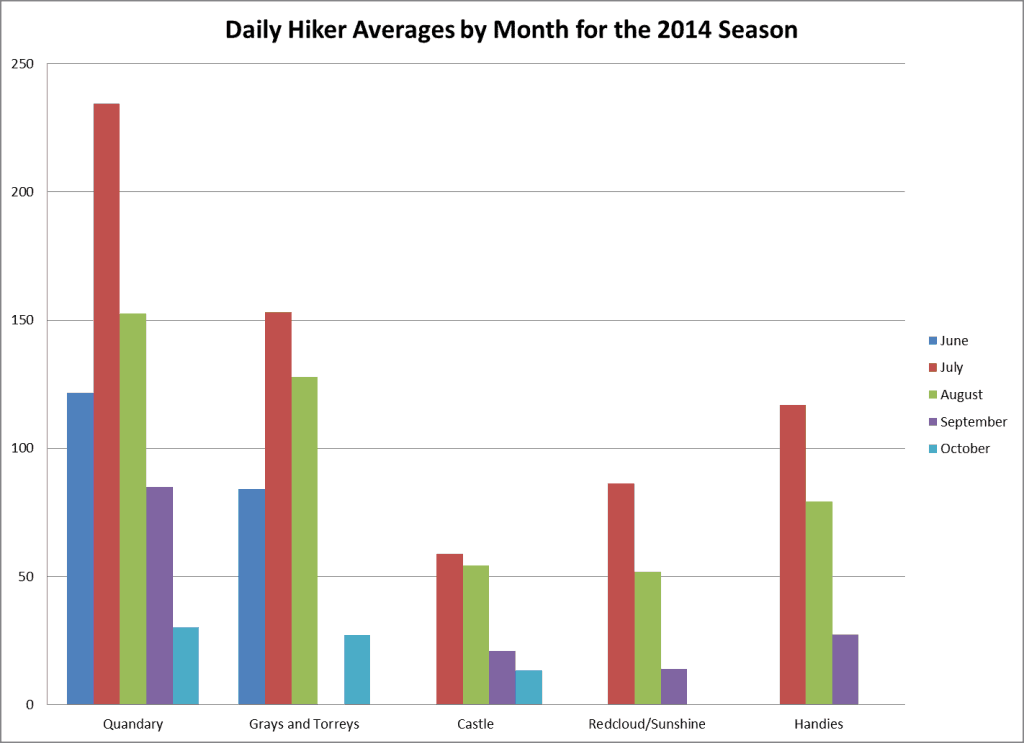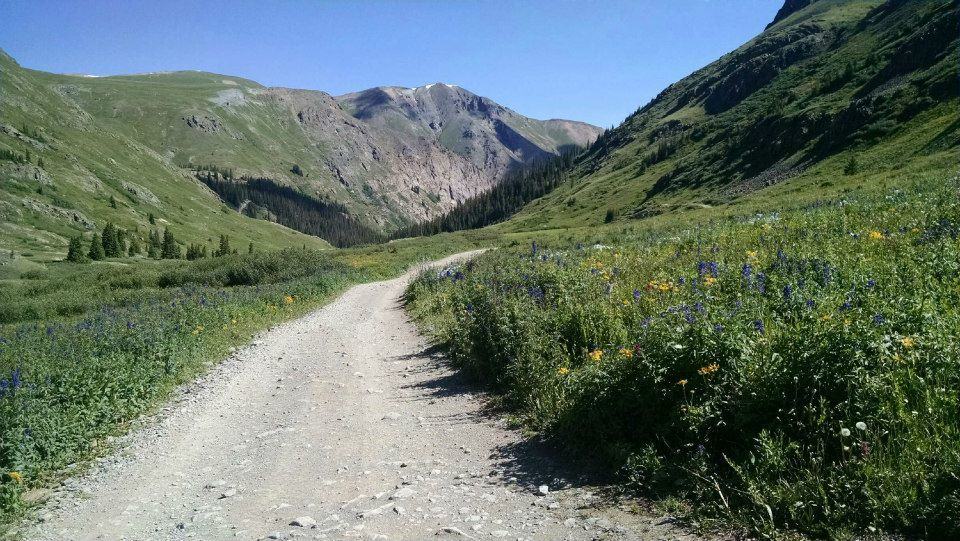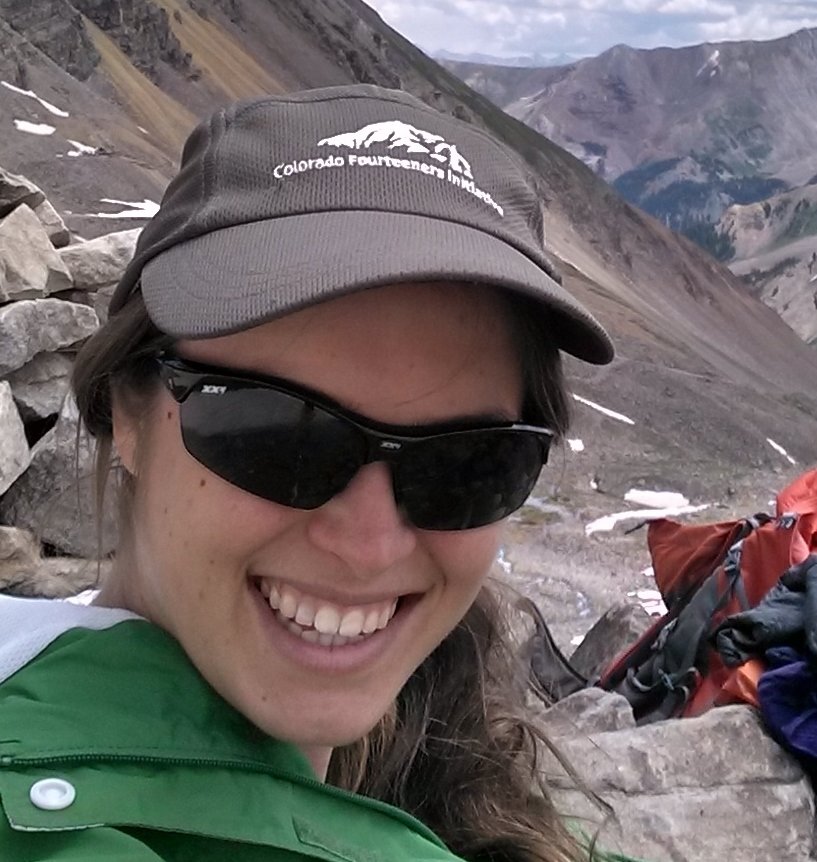This year, CFI placed five TRAFx infrared trail traffic counters on trails with access to seven Fourteeners: Castle, Quandary, Redcloud, Grays, Torreys, Handies, Sunshine. Overall, we consider the pilot year of our trail traffic counter project a success. After a season of data collection, we now have a better understanding of the value of this project and improvements we can make going into the next season of data collection.
Trail traffic counters provide the most accurate and complete picture of Fourteener usage. Several methods have been used previously determine how many people are hiking 14ers. A study by Jon Kedrowski in 2006 used trailhead registries to determine hiking traffic on Fourteeners. This method grossly misrepresents the number of hikers on a trail, as hikers will forget or choose not to sign a trailhead registry in a rush to start for the summit. CFI often uses volunteer peak stewards to collect hiker counts, however this data can only provide us with a brief snapshot of peak usage. In 2014, peak stewards collected hiker data on 19 routes, accessing 25 peaks total. Each route was visited for one to six days over the course of the season, and over half of those days were weekend days. Compare this to the trail traffic counters, which each collected 150 or more days of data, with every single weekend, weekday, and holiday represented. In addition to collecting hiker usage counts, peak steward counts are often underestimated, as peak stewards are distracted when educating hikers on Leave No Trace and sustainable hiking procedures. Weather and other random circumstances may also result in an unusually low number of hikers on a day when a peak steward may be visiting. In a comparison of the counter data with peak steward data for the same trail in 2014, it was found that peak stewards generally missed between 50-200 hikers on a given day. Although CFI’s Peak Steward Program is valuable for hiker education and outreach, it is certainly not the most effective method for determining usage among Fourteeners. Trail traffic counters are more effective because of their capability to provide us with a far more complete picture of hiker usage.
Trail traffic counters can give us more hiker data than any other method, but the question remains as to why we need all of this data. There are several reasons why this information is useful for CFI. First and most importantly, understanding the variations in usage among the Fourteeners can help us determine trail maintenance priorities. CFI is currently developing the Sustainable Trails Program, which will track on-the-ground trail conditions and maintain a database that will enable us to calculate which peaks are in the greatest need for maintenance. Hiker counts will be incorporated into this database and used to further help us assess where maintenance is most required based on hiker impact. Furthermore, it will help us determine whether the severe damage seen on many trails is due to a consistent period of high frequency hiking over the season, extraordinarily high bursts of hiking during discrete points throughout the season, or the combination of bad weather event and a burst in hiking frequency. This will help us determine how to best reconstruct a trail to minimize the time and cost of future maintenance. Second, these figures can help inform research projects concerning Fourteeners, such as recent research by Dr. Catherine Keske of CU Boulder analyzing the economic value of 14ers to surrounding mountain communities. With more hikers flocking to Fourteeners every season, mountain towns may see a correlative increase in their economies. This correlation is important to understand for infrastructural and development planning purposes. Countless other policies and hiking regulations regarding Fourteeners can also be informed based on accurate hiker count data.
Although our first year of data collection has resulted in a large database of hiker traffic, there is still missing data due to errors with the infrared counters. Weather was occasionally an issue, with snow and rain blocking the sensor beam or obscuring the trail so that hikers would not pass the sensor and remain uncounted. The biggest and most detrimental error was the placement of rocks by hikers in front of the infrared sensors. Although CFI staff worked hard to keep the counters completely hidden within rock cairns, hikers would often stop by to set rocks on top of the cairns or somehow tamper with the cairns, which would result in counts becoming obscured. CFI plans to fix this error by carefully constructing the cairns to make it impossible to place rocks in front of the counter. Furthermore, counters will be checked more frequently to ensure that they have not been obscured and that data is being collected.
Overall we are very pleased with our first year of data collection, and we are excited to collect long term data as we obtain more counters and keep them on these peaks for years to come. We would like to thank the Colorado Mountain Club, the Musser Fund, Aspen Skiing Company Environment Foundation, and Summit Foundation for helping fund this project.













